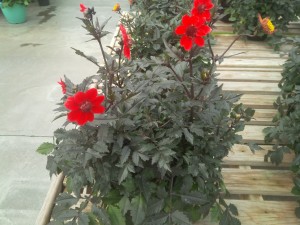 Opening up the new gardening catalogs is a form of post-holiday renewal. Despite the fact that I use lots of online vendors and do ninety-nine percent of my ordering online, I still get a thrill from the bright, splashy print catalogs.
Opening up the new gardening catalogs is a form of post-holiday renewal. Despite the fact that I use lots of online vendors and do ninety-nine percent of my ordering online, I still get a thrill from the bright, splashy print catalogs.
On New Year’s Day I delved into one of those catalogs. The vendor is an old and respected one that has long been a leader in the market for high quality perennials. In recent years they have also expanded their annual, edible and houseplant offerings to keep up with modern gardening trends. In fact, I use them as a bellwether in that regard.
When I opened their latest catalog, all I saw were dahlias—big ones, little ones, novelty varieties, and curated collections. Dahlias dominated the critical first five pages, and the total dahlia collection amounted to 125 individual varieties and collections. The numbers were proof positive that this particular vendor—and probably many others—are going all in on dahlias this year.
Why is this happening? There are probably a variety of reasons. Post-COVID people are longing for signs of hope. Dahlias, with their big, showy blooms, are cheerful and hopeful. They are also relatively easy to grow, as long as they start with warm soil and live in a sunny location. For gardeners who live and die by cut flowers, dahlias are stalwarts, looking equally good in casual arrangements and formal wedding bouquets. Depending on which varieties you choose, the flowers can look either old fashioned, or very modern. In an age when multitasking is nearly universal, they are horticultural multitaskers.
Today’s plants are a far cry from the species, which is native to Mexico, and made the long journey to Spain in about 1804, courtesy of European plant explorer Frederick van Humboldt. Lady Holland, wife of the British ambassador to Spain, introduced them to England, where the first flowers bloomed in the conservatory of the family’s estate, Holland House. Going by the name ‘Cocoxochitl” at first, the new plant was later referred to as “Georgina”, until the great plant taxonomist Linnaeus finally christened it “dahlia”, after one of his Swedish pupils, Anders Dahl.
The species dahlias cosseted by Lady Holland were subsequently propagated and hybridized, becoming popular as garden and florist’s flowers. They have gone in and out of fashion many times. The mid-twentieth century was dahlia time in many gardens, after which the plants languished for a couple of decades, derided for their lack of sophistication. Sophistication has clearly been redefined, and right now they are riding a renewed wave of popularity.
Dahlias also come in a variety of bloom styles, ranging from simple, single-petaled varieties to spiky-petaled cactus types, and bountifully upholstered waterlily styles. In recent years, many people have taken a shine to varieties, like the classic ‘Bishop of Llandaff’, that feature black or dark stems contrasting with bright-colored flowers.
The current catalog avalanche offers lots of favorite varieties, like the pinky-beige ‘Café au Lait’, which is reportedly a favorite in the florists’ trade. Antique varieties are also still available, including ‘Stolz von Berlin’, which made its debut in 1884. New introductions can be splashy, like the four-foot tall, sunset-colored ‘Jowey Chantal’, or more subtle, like little rose-colored ‘La Dee Da’. Some, including the bright red ‘Bodacious’, grow quite tall, with five foot stalks and blooms that reach a whopping 11 inches under good conditions. On the other hand, ‘Bambino’, with single white flowers, tops out at only 12 inches.
As garden flowers go, dahlias are easy to grow. Available either as tubers or young plants, all varieties should be given as much sun as roses or tomatoes—about six hours per day.
Once established, they don’t mind dry periods, but mulch is always helpful. Taller varieties, especially those with super-size flowers, will probably need the help of plant stakes
The only significant wrinkle in the fine fabric of dahlia existence is that the tubers are not hardy in cold winter climates. Some people solve that problem by simply treating the plants as annuals and discarding them at the end of the growing season. This is fine, but if you raise favorite varieties, heirlooms, or pricey new introductions, it is easy to lift the tubers in the fall and store them in a cool dry place for the winter, before replanting in the spring.
Whether you overwinter dahlias or buy fresh tubers, I find that starting the tubers indoors in pots is the best bet for getting a long season of bloom. When you plant, cover the tubers with only about two inches of soil. Water regularly when the top of the soil is dry to the touch, but don’t drown your dahlias, or they will rebel by rotting.
Because I am very impressionable, I now want scads of dahlias. I am going to try and manage the financial toll of this bout of enthusiasm by selecting older varieties, which tend to be less expensive than new introductions. If you have never raised dahlias before, I recommend this strategy.
For good selections, try either Swan Island Dahlias, PO Box 700, Canby, OR 97013, (800) 410-6540, www.dahlias.com; or White Flower Farm, P.O. Box 50, Litchfield, Connecticut 06759, (800) 503-9624; www.whiteflowerfarm.com. Paper catalogs available from both vendors.
